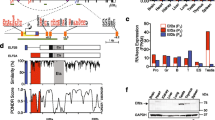Summary
It is not clear whether Down syndrome, the phenotypic expression of constitutional trisomy for chromosome 21 (T21), is the result of generalised disruption of homeostasis resulting from genetic imbalance, or the over-expression of specific genes on chromosome 21. In order to understand the effect of gene dosage more clearly, we have analysed the predicted and actual levels of expression of the leucocyte integrin β subunit CD 18 on the surface of T21 leucocytes. Previous studies showed that CD 18 expression by T21 lymphoid cell lines (LCL) is greater than on normal LCL. We have now developed a computer model that compares the observed and predicted CD 18 flow cytometric profiles for trisomy 21 LCL. Three parameters (α, β and γ) have been defined that measure different aspects of gene dosage. Using the computer model to calculate these parameters, we have carried out a series of paired comparisons between normal and T21 LCL. The results show that, in some T21 LCL, increased CD 18 expression is proportional to the existing gene dosage, in another set the effect is additive, whereas in others there is a combination of proportional and additive effects. The results suggest that gene regulation can exert pleiotropic effects on gene-dosage, and is consistent with a model in which gene dosage itself is the cause of disrupted homeostasis.
Similar content being viewed by others
References
Anneren KG, Korenberg JR, Epstein CJ (1987) Phosphofructokinase activity in fibroblasts aneuploid for chromosome 21. Hum Genet 76:63–65
Bardsley WG, McGinlay PB (1987) The use of non-linear regression analysis and the F test for model discrimination with doseresponse curves and ligand binding data. J Theor Biol 126:183–201
Bardsley WG, McGinlay PB (1989) Optimal design for model discrimination using the F-test with non-linear biochemical models. Criteria for choosing the number and spacing of experimental points. J Theor Biol 139:85–102
Bardsley WG, McGinlay PB, Wright AJ (1986) The F test for model discrimination with exponential functions. Biometrika 73:501–508
Bardsley WG, McGinlay PB, Roig MG (1987) Conditions when statistical tests for model discrimination have high power. Some examples from pharmacokinetics, ligand binding, transient and steady-state enzyme kinetics. Biophys Chem 26:1–8
Beatty PG, Ledbetter JA, Martin PJ, Price TH, Hansen JA (1983) Definition of a common leukocyte cell-surface antigen (Lp95–150) associated with diverse cell-mediated immune functions. J Immunol 131:2913–2918
Corbi AS, Larson RS, Kishimoto TK, Springer TA, Morton CC (1988) Chromosomal location of the genes encoding the leukocyte adhesion receptors LFA-1, Mac-1 and p150–95. J Exp Med 167:1597
Epstein CJ (1986) The consequences of chromosome imbalance. Principles, mechanisms and models. Cambridge University Press, Cambridge
Feaster WW, Kwok LW, Epstein CJ (1977) Dosage effects for superoxide dismutase-1 in nucleated cells aneuploid for chromosome 21. Am J Hum Genet 29:563–570
Kishimoto TK, Hollander N, Roberts TM, Anderson DC, Springer TA (1987) Heterogeneous mutations in the β subunit common to the LFA-1, Mac-1 and p150,95 glycoproteins cause leukocyte adhesion deficiency. Cell 50:193–202
Klose J, Zeindl E, Sperling K (1982) Analysis of protein patterns in two-dimensional gels of cultured human cells with trisomy 21. Clin Chem 28:987–993
McMichael AJ (ed) (1987) Leucocyte typing III. White cell differentiation antigens. Oxford University Press, Oxford
McMurray BP, Taylor GM, Williams A, D'Souza S, Harris R (1989) Sequential flow cytometric analysis of cell-cycle related changes in LFA-1 (CD18/CD11a) expression by trisomy 21 (Down's syndrome) lymphoblastoid cells. Cell Tissue Kinet 22:223–233
Overton WR (1988) Modified histogram subtraction technique for analysis of flow cytometry data. Cytometry 9:619–626
Robson AJ, Taylor GM, D'Souza SW (1989) Monoclonal antibodies to CD 18 and CD 11a (LFA-1) distinguish Down's syndrome (trisomy 21) from normal lymphoblastoid cells. Disease Markers 7:169–180
Shapiro BL (1983) Down syndrome —a disruption of homeostasis. Am J Med Genet 14:241–269
Shapiro HM (1985) Practical flow cytometry. Liss, New York
Solomon E, Palmer R, Hing S, Law SKA (1988) Regional localisation of CD18, the β-subunit of the cell surface adhesion molecule LFA-1, on human chromosome 21 by in situ hybridisation. Ann Hum Genet 52:123
Springer TA, Thompson WS, Miller LJ, Schmalstieg FC Miller LJ, Schmalstieg FC, Anderson DC (1984) Inherited deficiency of the Mac-1, LFA-1, p150,95 glycoprotein family and its molecular basis. J Exp Med 160:1901–1918
Taylor GM (1987) Altered expression of lymphocyte functional antigen in Down syndrome. Immunol Today 8:366–369
Taylor GM, Williams A, D'Souza SW, Fergusson WD, Donnai D, Fennel J, Harris R (1988) The expression of CD 18 is increased on trisomy 21 (Down syndrome) lymphoblastoid cell-lines. Clin Exp Immunol 71:324–328
Taylor GM, Braddock D, Robson AJ, Fergusson WD, D'Souza SW, Brenchley P (1990) Expression of LFA-1 by a lymphoblastoid cell line from a patient with monosomy 21: effects on intercellular adhesion. Clin Exp Immunol 81:501–506
Author information
Authors and Affiliations
Rights and permissions
About this article
Cite this article
Bardsley, W.G., McMurray, B.P., Robson, A. et al. Analysis of gene-dosage effects on the expression of CD18 by trisomy 21 lymphoblastoid cell-lines using a statistical model to fit flow cytometry profiles. Hum Genet 86, 181–186 (1990). https://doi.org/10.1007/BF00197702
Received:
Revised:
Issue Date:
DOI: https://doi.org/10.1007/BF00197702




